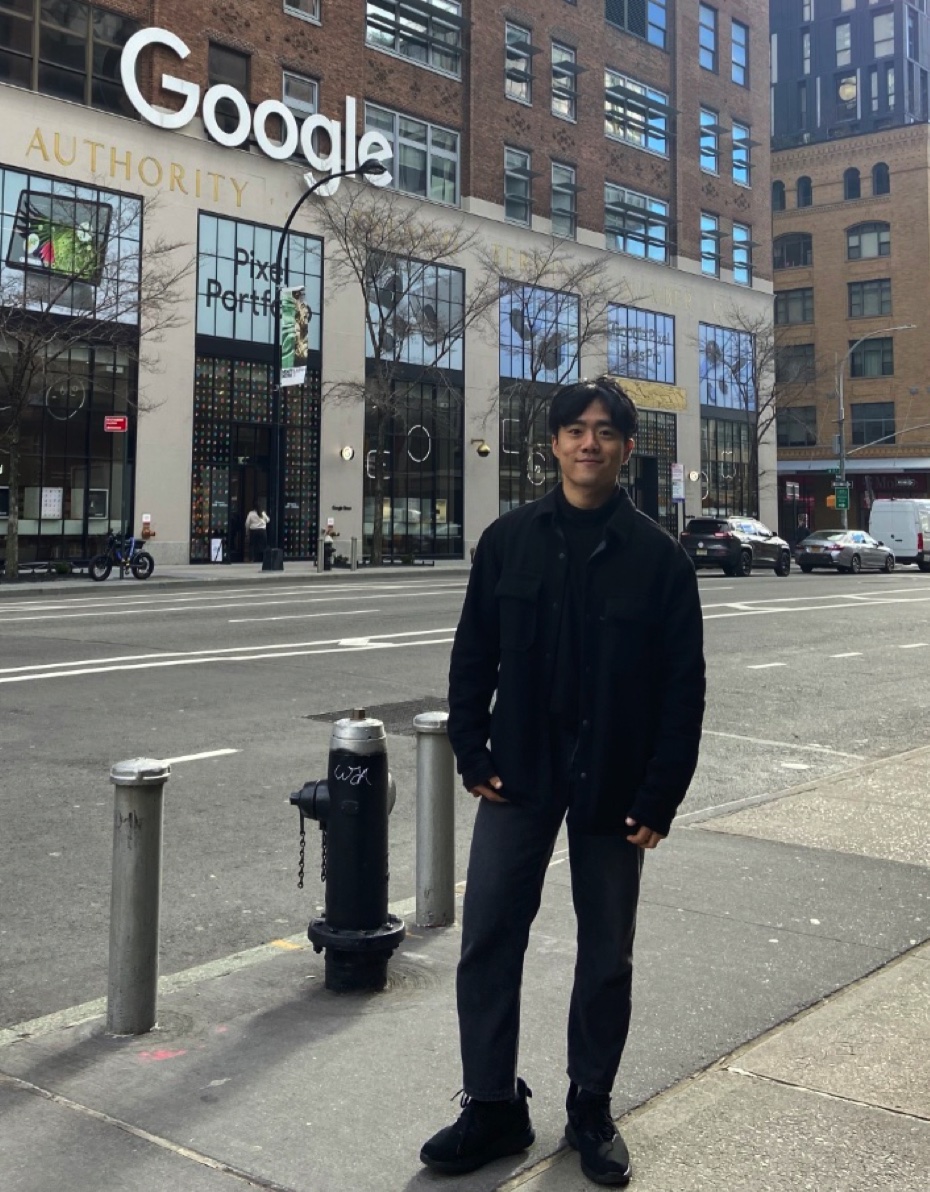Fine-Grained Abnormality Prompt Learning for Zero-shot Anomaly Detection (arxiv, 2024)
Zhu, Jiawen, et al. "Fine-grained Abnormality Prompt Learning for Zero-shot Anomaly Detection." arXiv preprint arXiv:2410.10289 (2024).
참고: https://www.youtube.com/watch?v=QwEgPwCnF88
( https://arxiv.org/pdf/2410.10289 )
Contents
- (1) Overview
- (2) Background
- Text Prompt
- (3) Methods
- Compound abnormality prompt (CAP) learning
- Data-dependent abnormality prompt (DAP) learning
- Training
- Inference
1. Overview
FAPrompt = Fine-grained Abnormality + Prompt
구성 요소
- (1) Compound Abnormality Prompting (CAP)
- (2) Data-dependent Abnormality Prompting (DAP)
CAP vs. DAP
-
CAP: 다양한 종류의 abnormality prompt 구성
\(\rightarrow\) 다양한 비정상 패턴 학습 가능
-
DAP: 위를 통해 세분화된 abnormality를 통해, 다양한 데이터셋에 대해서 일반화 \(\uparrow\)
학습 과정
- CLIP의 (대부분) 원본 파라미터는 freeze
- Text Encoder의 일부 learnable token는 (ab)normality prompt에 따라 update
2. Background
(1) Text Prompt
VLM (e.g., CLIP)은 ZSAD task에서 뛰어난 모습을 보여왔음
AD task에 VLM을 적용하기 위해, 정상/비정상 textual semantic 추출이 필요!
두 종류로 나뉨
- (1) Handcrafted text prompt (e.g., WinCLIP, AnoVL)
- (2) Learnable text prompt (e.g, AnomalyCLIP)
a) Handcrafted text prompt
다양한 종류/패턴의 abnormality가 존재할 수 있음.
\(\rightarrow\) 이를 모두 커버하기 위해, “넓은 범위의 사전 학습된 token”을 text prompt에 포함시킴
Examples
- State-aware token: damaged, imperfect, defective …
- Domain-aware tokens: industrial, manufacturing, surface ..
b) Learnable text prompt
normal & abnormal class에 대한 learnable한 token
- \(g_n =\left[V_1\right]\left[V_2\right] \ldots\left[V_E\right][\text { object }]\).
- \(g_a =\left[W_1\right]\left[W_2\right] \ldots\left[W_E\right][\text { damaged }][\text { object }]\).
c) Proposed method
두 종류의 prompt를 비판함!
\(\rightarrow\) 둘 다 너무 coarse-grained semantic 에만 집중하고, fine-grained semantic을 간과한다!
( 때문에, coarse-grained abnormal pattern과는 조금 상이한 abnormal pattern는 탐지 실패할 수도!)
=> Proposal: FAPrompt
FAPrompt
Fine-grained abnormality pattern을 탐지할 수 있는 Text prompt를 학습하자!
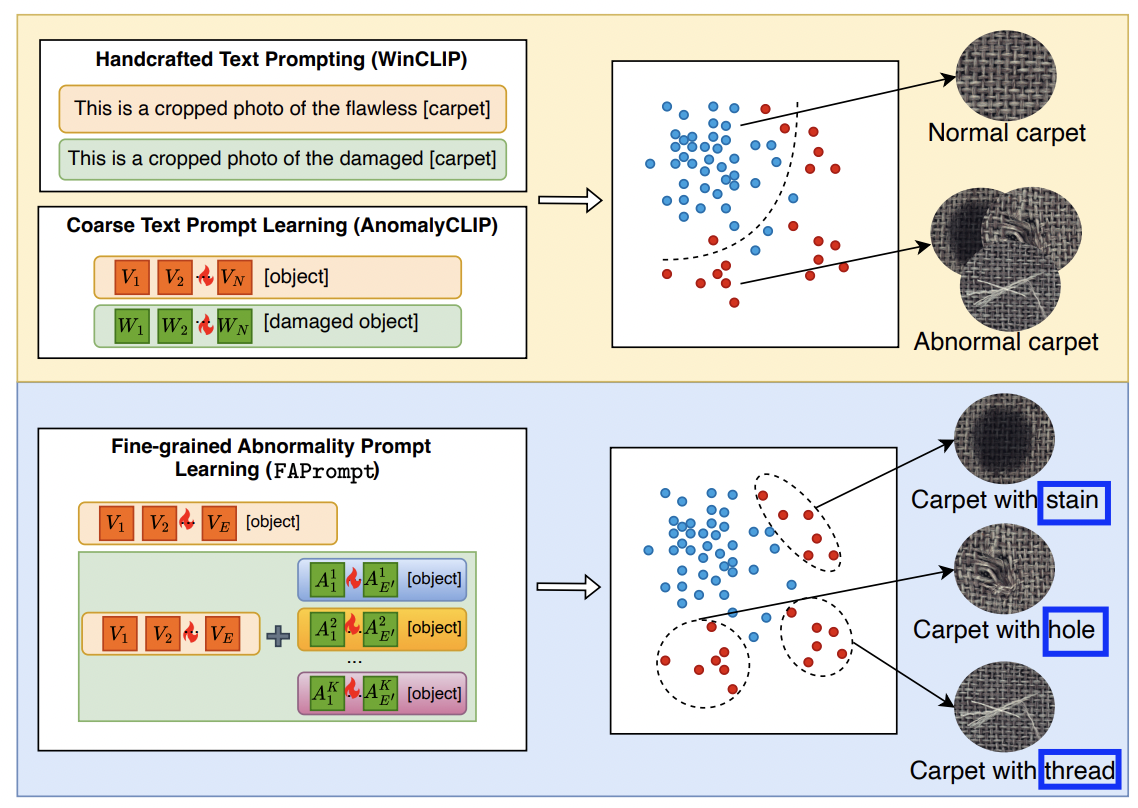
3. Methods
Overview
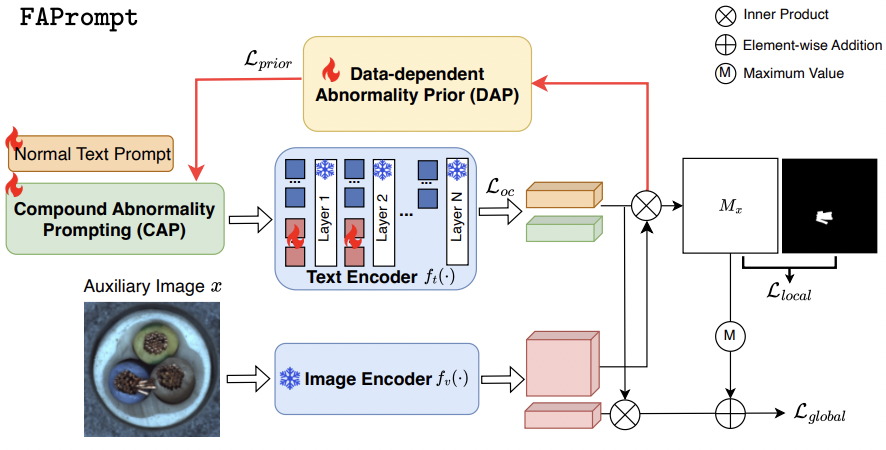
(1) Compound Abnormality Prompt Learning (CAP)
Abnormal image = 편차가 크다
- 얼룩 vs. 긁힘 vs. 색 변조 … => 너무 상이하다!

해결 방법: CAP
- “세분화된” Abnormality prompt를 사용하여, “다양한” 비정상 패턴을 학습하자
CAP의 prompt
- Normal text prompt: \(\mathcal{P}^n =\left[V_1\right]\left[V_2\right] \ldots\left[V_E\right][\text { object }]\)
- Abnormal text prompt: \(\mathcal{P}^a =\left\{\mathcal{P}^{a_1}, \mathcal{P}^{a_2}, \ldots \mathcal{P}^{a_K}\right\}\).
- with \(\mathcal{P}^{a_i}=\left[V_1\right]\left[V_2\right] \ldots\left[V_E\right]\left[A_1^i\right]\left[A_2^i\right] \ldots\left[A_{E^{\prime}}^i\right][\text { object }]\).
-
Notation
- \(E\): normal token 개수 (default: 5)
- \(E^{'}\): abnormal token 개수 (default: 2)
- \(K\): fine-grained abnormal prompt 개수 (default: 10)
-
주의 사항: Abnormal text prompt 또한, (abnormal 임에도 불구하고) normal prompt를 공유한다!
\(\rightarrow\) abnormal을 normal과 가깝게 유지시키기 위해!
Orthogonal constraint loss \(L_{oc}\)
최대한 다양한/상이한 abnormal prompt를 가지게 유도하기 위해!
- (본인을 제외한) 나머지 abnormal prompt와의 cosine similarity가 낮도록!
\(\mathcal{L}_{o c}=\sum_{i, j \in K ; i \neq j} a b s\left(\frac{f_t\left(\mathcal{P}^{a_i}\right) \cdot f_t\left(\mathcal{P}^{a_j}\right)}{\mid \mid f_t\left(\mathcal{P}^{a_i}\right)\mid \mid \times\mid \mid f_t\left(\mathcal{P}^{a_j}\right)\mid \mid }\right)\).
최종으로 사용하는 임베딩
- Normal prompt: \(F_{n}=f_t\left(P^n\right)\)
- Abnormality prompt: \(\mathbf{F}_a=\frac{1}{ \mid \mathcal{P}^a \mid } \sum_{\mathcal{P}^{a_i} \in \mathcal{P}^a} f_t\left(\mathcal{P}^{a_i}\right)\).
- 전체 abnormality prompt embedding의 평균
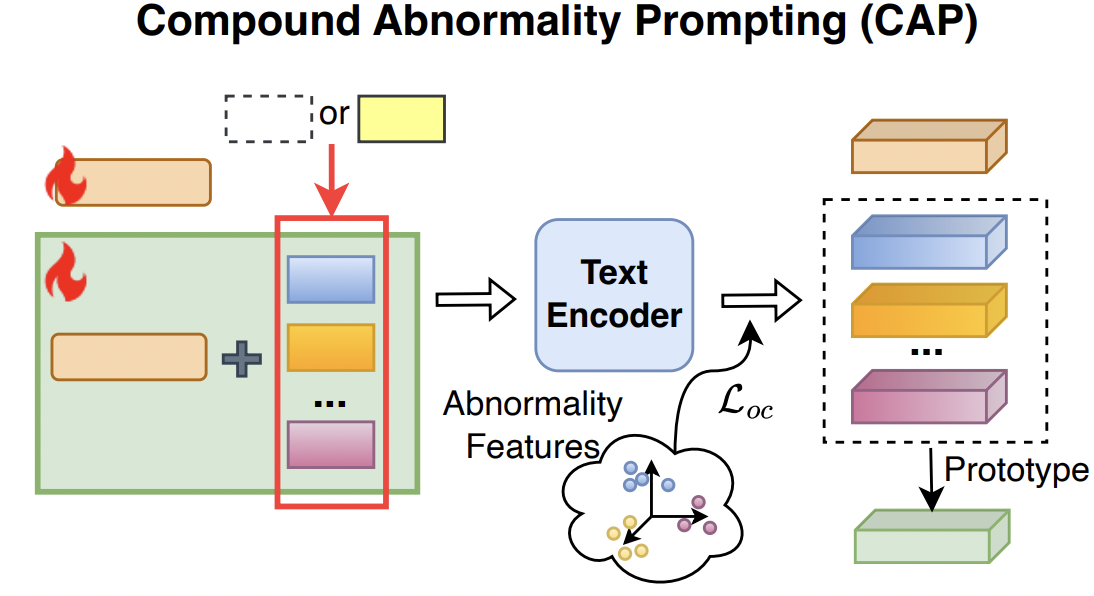
(2) Data-dependent Abnormality Prompt Learning (DAP)
Background
ZASD에서, 모델 학습에 사용된 데이터셋 & 실제 테스트 데이터셋은 매우 상이할 수 있음!
\(\rightarrow\) Importance of generalization ability
따라서, 학습된 abnormal token의 일반화 능력을 향상시키기 위한 DAP를 제안
Idea) “가장 abnormal”한 영역의 임베딩을 선택하여, (sample-wise) abnormality prior로써 사용하자!
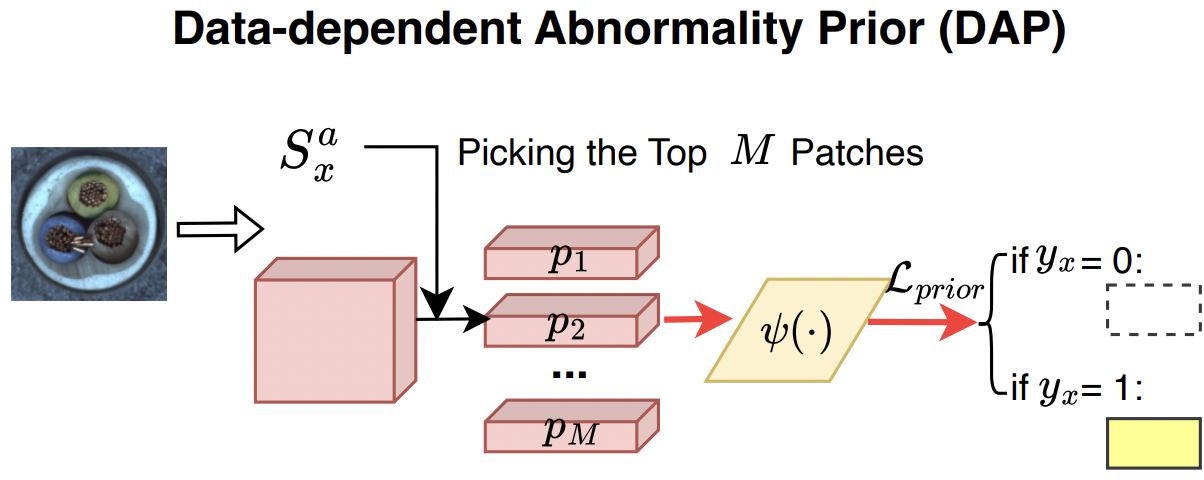
Procedure
요약: Test image \(x\)에 대해, “가장 비정상적인 image patch”를 abnormality prior로 CAP에 입력
Step 1) 이미지 내의 여러 패치들 중, 비정상 프롬프트와 가장 유사한 패치를 찾는다!
-
비정상적이다? Anomaly score로써 계산! (아래 식 참고)
-
\(\mathbf{S}_x^a(i, j)=\frac{\exp \left(\mathbf{F}_v(i, j) \mathbf{F}_a^{\top}\right)}{\exp \left(\mathbf{F}_v(i, j) \mathbf{F}_n^{\top}\right)+\exp \left(\mathbf{F}_v(i, j) \mathbf{F}_a^{\top}\right)}\).
-
\(M\): 패치 임베딩 개수
-
\(F_v(i,j)\): 패치 임베딩
-
\(S_x^a(i,j)\): 패치 단위의 anomaly score
-
Step 2) Top M개의 abnormal한 패치 임베딩을 선정한다.
Step 3) Top M개의 임베딩을 abnormality prior network에 통과시킨다.
- (1) 패치 임베딩: \(p_x=\left(p_1, p_2, \ldots, p_M\right)\)
- (2) Abnormality prior network: \(\psi(\cdot)\)
Step 4) 나온 결과값 ( = \(\psi(p_x)\))을 abnormal token에 더한다.
- \(\hat{\mathcal{P}}^{a_i}=\left[V_1\right]\left[V_2\right] \ldots\left[V_E\right]\left[A_1^i \oplus \Omega_x\right]\left[A_2^i \oplus \Omega_x\right] \ldots\left[A_{E^{\prime}}^i \oplus \Omega_x\right][\text { object }]\).
Step 5) 최종 Abnormality prompt
- (w/o DAP) \(\mathbf{F}_a=\frac{1}{\mid \mathcal{P}^a\mid } \sum_{\mathcal{P}^{a_i} \in \mathcal{P}^a} f_t\left(\mathcal{P}^{a_i}\right)\)
- (w/ DAP) \(\hat{\mathbf{F}}_a=\frac{1}{ \mid \hat{F} a \mid } \sum_{p, p \in p^a} f_t\left(\hat{p}^{a_i}\right)\)
Abnormality prior learning loss \(L_{\text{prior}}\)
Top M개의 비정상적인 패치 정보를 더한다?
What if 정상 이미지? ( = 억지로 M개를 추가하는 것이 아닐지? )
\(\rightarrow\) 이럴 경우, prior 적용은 오히려 학습에 방해가 될 것!
Solution: abnormality prior learning loss
- \(\mathcal{L}_{\text {prior }}=\sum_{y_x=0} \sum_{\omega \in \Omega_x} \omega_x^2\).
- \(x\)가 abnormal: \(M\)개의 패치
- \(x\)가 normal: NULL
(3) Training
Abnormal segmentation map
-
최종 abnormality prompt: \(\hat{\mathbf{F}}_a=\frac{1}{ \mid \hat{F} a \mid } \sum_{p, p \in p^a} f_t\left(\hat{p}^{a_i}\right)\)
-
이에 대한 anomaly map 생성 (based on 아래의 anomaly score)
- \(\mathbf{S}_x^a(i, j)=\frac{\exp \left(\mathbf{F}_v(i, j) \mathbf{F}_a^{\top}\right)}{\exp \left(\mathbf{F}_v(i, j) \mathbf{F}_n^{\top}\right)+\exp \left(\mathbf{F}_v(i, j) \mathbf{F}_a^{\top}\right)}\).
- \(\hat{\mathcal{M}}^a=\Phi\left(\hat{S}_x^a\right)\),
- where \(\Phi\): reshape & interpolation
Normal segmentaiton map
- 위와 같은 방식으로!
a) Pixel-level AD
(AnomalyCLIP과 동일하게) Pixel-level loss 계산을 통해 optimize
\(\mathcal{L}_{\text {local }}=\frac{1}{N} \sum_{x \in X_{\text {trais }}} \mathcal{L}_{\text {Focal }}\left(\left[\hat{\mathcal{M}}^n, \hat{\mathcal{M}}^{\mathrm{a}}\right], \mathbf{G}_x\right)+\mathcal{L}_{\text {Dice }}\left(\hat{\mathcal{M}}^a, \mathbf{G}_x\right)+\mathcal{L}_{\text {Dice }}\left(\dot{\mathcal{M}}^{\mathrm{n}}, \mathbf{I}-\mathbf{G}_x\right)\).
- \(\mathbf{G}_x\): ground-truth mask
- \(\mathbf{I}\) : one matrix
b) Image-level AD
- Test image \(x\) & normal/abnormal prompt embedding간의 유사도 계산
- \(s_a(x)=\frac{\exp \left(f_v(x) \hat{\mathbf{F}}_a^{\top}\right)}{\exp \left(f_v(x) \mathbf{F}_n^{\top}\right)+\exp \left(f_v(x) \hat{\mathbf{F}}_a^{\top}\right)}\).
최종 Image-level anomaly score:
= image-level score & pixel-score의 최대값 간의 평균값
- \(s(x)=\frac{1}{2}\left(s_a(x)+s_a^{\prime}(x)\right)\).
- where \(s_a^{\prime}(x)=\frac{1}{2}\left(\max \left(S_x^a\right)+\max \left(\hat{S}_x^a\right)\right)\).
Image-level loss
\(\mathcal{L}_{\text {global }}=\frac{1}{N} \sum_{x \in X_{\text {train }}} \mathcal{L}_b\left(s(x), y_x\right)\).
- \(\mathcal{L}_b\): focal loss ( due to imbalance in train dataset )
c) 전체 Loss
\(\mathcal{L}=\mathcal{L}_{\text {local }}+\mathcal{L}_{\text {global }}+\mathcal{L}_{\text {prior }}+\mathcal{L}_{o c}\).
(4) Inference
Test image \(x^{'}\)이 주어지면, CLIP의 visual encoder를 통과하여, 4종류의 segmentation map을 생성함..
그런 뒤, pixel-level anomaly map을 아래와 같이 계산함!
- \(\mathcal{M}_{x^{\prime}}=\frac{1}{4}\left(\mathcal{M}^a \oplus 1 \ominus \mathcal{M}^n \oplus \hat{\mathcal{M}}^a \oplus 1 \ominus \hat{\mathcal{M}}^n\right)\).
( image-level anomaly score는, 앞서 언급한 것 처럼 )
- \(s(x)=\frac{1}{2}\left(s_a(x)+s_a^{\prime}(x)\right)\).
